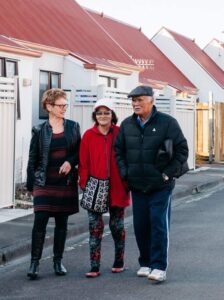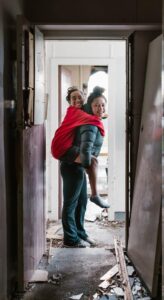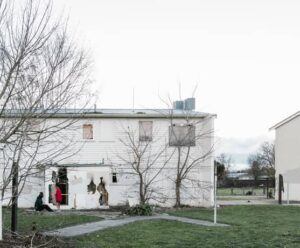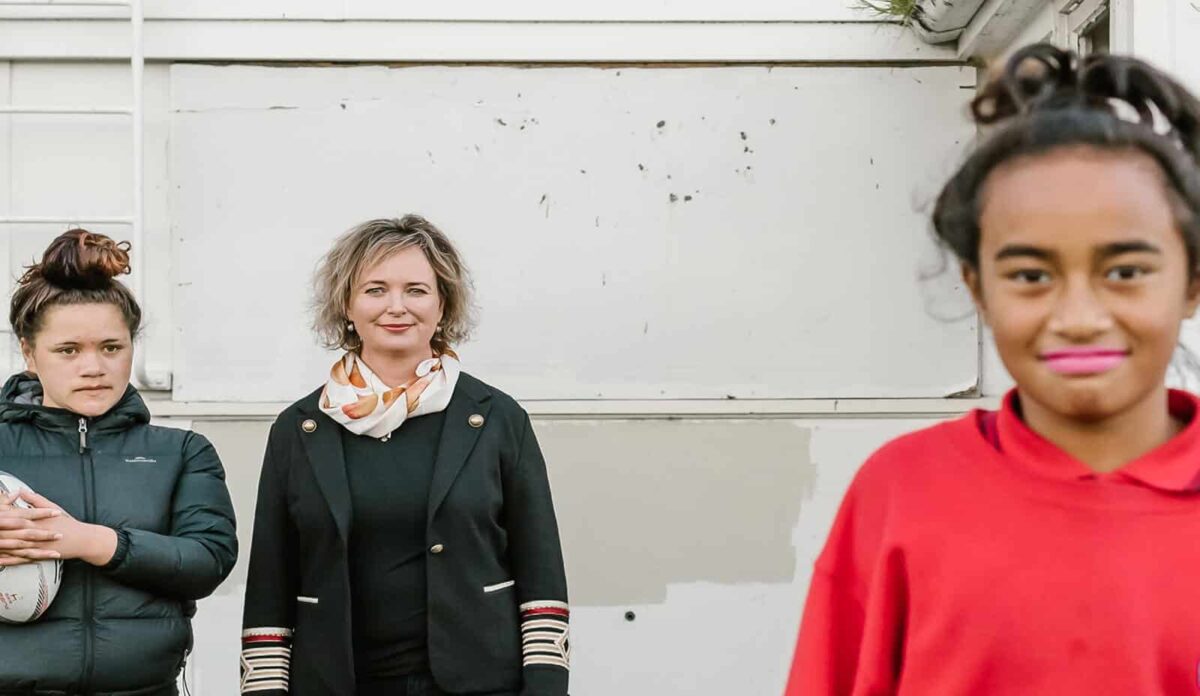“So, we have the situation where the government has been pig-headed and sold o our state assets, and is now turning around and having to buy back property, competing on the residential market, while former Housing NZ land remains barren.” ANNA LORCK
I’M ON THE ROAD WITH Labour candidate Anna Lorck in Hastings. “Everywhere I go,” she says, “it’s housing, housing, housing. I have done nearly 80 street corner meetings now, and there is not a meeting where someone doesn’t talk about it.”
Over the year ending May 2017, house prices across Hawke’s Bay climbed 20%, while rents rose 9.4% (double the national average), fuelled by a lack of listings and vacant residential land, on the one hand, and an influx of out-of-town buyers on the other. To some this reflects our attractiveness as a destination, but for others, it’s part of a systemic failure in leadership.
According to the Real Estate Institute of NZ, Hawke’s Bay has the lowest housing supply in the country, with no slow-down in demand.
The private market has become inaccessible and unaffordable for many, and with 40+ applicants at rental viewings, skewed against families, the young and unattached, beneficiaries, pensioners, those with ‘history’, and Maori. Frontline advocates report incidents of flagrant racism and exclusion in an environment where landlords can cherry-pick their tenants.
Compounding the private market squeeze is a shortage of suitable, state- subsidised housing for those with lowest incomes. Numbers on the social housing register have dramatically increased in the last couple of years, with 135 listed in Napier and 104 in Hastings.
These figures represent those with most urgent need of shelter, a rough indicator of the homeless within the system. Unaccounted for are all those living in garages, overcrowded or substandard houses; we have some of the worst statistics for this (and associated health issues like rheumatic fever and respiratory illness) in the country.
We now have the visibly homeless in our urban centres, people parked up in cars on the beach or dossing down in public spaces. To put people up in motels, backpackers, etc., some $500,000 was spent in the first quarter of 2017 alone on Emergency Housing Grants in the twin cities, with Napier taking the lion’s share.
The private market has become inaccessible and unaffordable for many, and with 40+ applicants at rental viewings, skewed against families, the young and unattached, beneficiaries, pensioners, those with ‘history’, and Maori.
How has it come to this, and what needs to be done to address the widening gap in housing security?

Depleted stock Nationwide, our stock of state houses is at its lowest level, relative to population, since the severe housing shortages of the 1940s, which propelled an ambitious programme of state housing in the 1950s. Under successive governments since the 1980s, however, new state house investment has steadily declined. As of July 2016, more than 4,000 state homes had been either sold or demolished in the five years prior, with Hawke’s Bay down 377 state houses – or in MSD parlance, ‘social housing places’.
In 2011, for instance, 96 state housing units were demolished in Maraenui; they were “old, rickety” and supposedly didn’t meet earthquake standards, but where there were homes, there are now empty plots. “The spin we got from Housing NZ,” Napier councillor Maxine Boag explains, “is that they would replace them: a third would be redeveloped by HNZ, a third by other social housing providers and a third by private housing developers. [HNZ] built seven new houses and that was that. Nothing has happened since.”
Napier has three registered social housing providers, but at this stage two have no actual housing available, so that leaves just Housing NZ. “For the government to say, ‘We’re handing over to other social housing providers’, well, there aren’t any. The government has divested and there’s a vacuum right now.”
A disconnected system
Maraenui Community House, established in March this year by Tu Tangata Maraenui Trust, runs a walk-in centre for addictions, a ‘koha shed’ with secondhand clothing and household items, and advocacy services, providing a vital hub for people to share stories over cups of tea at the kitchen table. I arrive as someone from a local business is dropping o a bag of sticky buns.
There’s not a lack of houses so much as a lack of common sense, and it’s frustrating. “People’s needs get chucked up on a data base and then electronically matched,” and the human nuance of the situation is often lost. MINNIE RATIMA (CENTRE) IN HER WHARE, MARAENUI COMMUNITY HOUSE
Kahu is celebrating getting a house – it took her six, stressful months living week- to-week in emergency accommodation, trying to hold down two jobs as a caregiver. Her earnings were too high to qualify her for a social housing place, but too low to afford market rents and she had ‘history’ sitting in the tenancy tribunal. The community house gave her the stability of a base, a ‘home’ when she didn’t have one of her own.
Social housing advocate Minnie Ratima says having a community-owned, community-run centre allows for real engagement and a degree of pride and respect that people don’t feel they get from government agencies. “There is no judgement and no rules in this whare, just one expectation: that you practise the principles of manaakitanga.”
Minnie says there’s not a lack of houses so much as a lack of common sense, and it’s frustrating. “People’s needs get chucked up on a database and then electronically matched,” and the human nuance of the situation is often lost. There’s little sense of care or appropriateness, she says. Like when ‘Hine’ fled an abusive relationship with her 10 kids, only to eventually be assigned the house she had moved out from in the first place, next door to her violent ex-partner.

Changes to HNZ’s social housing eligibility criteria in 2014 have left people having to prove they’re in dire straits to receive support. As a result, says Minnie, many, facing financial stress and housing insecurity, are struggling to hold it together.
“Policy has broken up families”, and it’s particularly hard on the men, who are more likely to give up and go it alone. Minnie’s seen ‘tough’ men cry with the humiliation they experience trying to find accommodation. “Jail is looking pretty good for people to move in to,” she says wryly. “You get programmes that can lead to jobs, three meals a day and a bed.”

“For the government to say, ‘We’re handing over to other social housing providers’, well, there aren’t any. The government has divested and there’s a vacuum right now.” MAXINE BOAG
Minnie knows all the empty houses in the area, their histories, and what her people’s needs are on the ground. She says in 2013, she had an agreement with HNZ to refer whanau for housing, and it worked well. But since WINZ took over the referral process there’s been a complete disconnect; housing assessment in Hawke’s Bay is now overseen from an office by one person.
She believes “It needs to go back to community assessments – MSD doesn’t work, the process for applying is so ridiculously complex.” The specific questions.”
The specific questions I put to Housing NZ and MSD on the Hawke’s Bay situation result (via an email chain of charming Wellington civil servants) in careful, bland statements “attributed” to HB area officer for Housing NZ, Andrew Cairns, and to deputy CEO of Housing, MSD, Scott Gallacher. “The relationship between MSD and Housing NZ started off on solid foundations,” they assure me, “and has continually been improving as the inter-agency processes bed in but both agencies believe they can do better.” And: “With both short-term and longer-term policies in play we’re in a good place to make sure we can help those families in need.”
Homelessness
Eighty percent of Napier’s “homeless” (there are 20 “sleeping rough” at any one time, but numbers are higher when you include those “without shelter”, i.e. living in cars, and “temporary accommodation” such as camping grounds) are Maori, the majority men, average age 50. The number has doubled within the last five years. Most have exhausted Housing NZ resources, private rentals and WINZ emergency support; many struggle with issues such as mental health, addiction, past trauma, and a general lack of support.
The Napier Cross Sector Group (comprising local council, community and government agencies) has been working to find solutions and wrap-around support. In their submission to the Cross-Party Inquiry into Homelessness last year, they concluded, “the problem … is likely to continue to grow unless policies change at a national level to support more provision of social housing, there is better coordination between MSD and social housing providers and there is provision for funding to services to support those with complex needs.”
An ageing population
In a neatly kept cul-de-sac of family state homes, built in the last big wave of state housing in the 1970s, I meet Bob, who’s been served his eviction notice now that his kids are grown and his house deemed surplus to need. He and his wife, both in their 60s, have been “sent through the wringer”, he says. The banks won’t loan them money to buy the house they have lived in for 20+ years (the mortgage repayments would exceed their weekly income), they can’t afford to rent anywhere else, and they’ve been offered no alternative. The couple next door in their 70s (still working, minimum wage) are also on notice after 30 years of good tenancy – they too can’t find anything affordable: “We don’t know what we’ll do.”
Hawke’s Bay’s ageing population is projected to exponentially increase over the next three decades. Our councils have identified that 3,340 more senior housing places will be needed by 2045, half of which will be in private retirement villages. But for those without assets to sell and who live solely from the pension, there’s a need for subsidised ‘pensioner flats’, and that’s already proving a challenge.
Currently, Napier City Council maintains 303 such flats, Hastings City District, 220, and the Masonic Trust, 75 – all built over 30 years ago. But, according to Maxine Boag, who also represents Grey Power, the wait- lists are well over a year, and the elderly are finding themselves competing for places with other low-income residents who are no longer eligible for state homes. Unless there’s a direct mandate from ratepayers, there is little prospect at this stage of councils building more.
Maxine knows of many elderly living with their (extended) families in overcrowded, indefinite arrangements – stressful for everyone involved. She says it’s “heartbreaking” for staff because they simply can’t offer anything.
Land held up
When I interview Lawrence Yule in his last weeks as Hastings mayor, he concedes that he doesn’t know what the actual shortages of government-housing stock in the area are, but is cognisant of the fact that “over a number of governments, investment in Housing NZ has not kept up.”
While he’s seen overcrowded houses in Flaxmere first hand and believes issues with quality (cold, mouldy homes) need to be addressed “head on”, Yule says, “My sense is there is enough accommodation here … people shouldn’t be homeless.” He points to the emergency housing options available, “I have yet to hear of a case that hasn’t been helped”.
He “accepts that it’s become a challenge for people”, but doesn’t believe there’s a housing crisis in Hawke’s Bay.
A shortfall in available residential land is contributing to the current bottleneck, explains Yule. Where people might have built a new house, they can’t find a section and so buy an existing property – the cycle is “out of sync” and Council “needs to release more land, as quickly as we can.”
Yule is confident that the land supply shortage will be relieved by Christmas, with 1,560 more sections pending release, some as of July, and many sections, such as the Frimley development, already sold off plan.
Fixing the housing “situation” is “a matter of allocating resource”, and Yule is “keen to advance” training and industry engagement to build more affordable homes, like the ‘build a bach’ concept, which draws on an apprentice- ship system. “Apparently it’s been a stunning success… and it ticks a whole lot of boxes.”
The couple next door in their 70s (still working, minimum wage) are also on notice after 30 years of good tenancy – they too can’t find anything affordable: “We don’t know what we’ll do.”
“We have to reconfigure our housing stock, supply more sections and try and put downward pressure on the cost of housing, but I haven’t got people constantly calling me about this, and sections are coming on.”
“Of course, this might change,” he adds quickly, “if I’m elected MP”, implying a role that entails more direct advocacy.

Emergency housing
Local constituents are “constantly calling” Meka Whaitiri’s electoral office in Hastings – up to twelve people a week. And they’re desperate: facing eviction, living in cars, garages, cramped motel units, trapped in a bureaucratic nightmare, or digging deeper and deeper into debt as they try to cover unaffordable rents. The Ikaroa-Rawhiti MP has been vocal on this, writing articles in the local paper, petitioning government: “The council can’t say they don’t know.”

One issue appears to be the out-of-town displaced, who are often prioritised for urgent housing because they have nowhere else to go, ahead of locals in garages and overcrowded houses, who at least have a roof over their head.
Central Hawke’s Bay mayor, Alex Walker, says the demand for social housing in her community (which faces similar housing pressures), is pushing some to move to Hastings and Napier where there are more perceived options. But this removes them from family and support networks, and “transfers the burden to the cities”. There are also anecdotal reports of Auckland ‘refugees’ moving south.

In June, MSD announced that in addition to securing 30 emergency housing places in Hawke’s Bay, it aims to create 129 short-term places by the end of the year, calculated to benefit 711 local families per annum, providing each with 12 weeks of accommodation and support to “transition” them into more “sustainable” housing. It also intends to purchase 195 social housing places over the next three years.
When I speak with Maxine Boag, her response is wary: “At least there’s some acknowledgement now of the issue, but really, it’s too little, too late, and it’s not going to alleviate the housing crisis. I note that the emphasis is on transitional housing, but where do families go after three months?”
Community regeneration
Anna Lorck has it on paper that between 2012-2015 alone, 118 state houses were sold in Hastings, Havelock North and Flaxmere, many below government values and to private investors. She sees the irony in the new ‘social housing places’ promised by MSD as part of its “ambitious” Purchasing Strategy for the area.
“So, we have the situation where the government has been pig-headed and sold o our state assets, and is now turning around and having to buy back property, competing on the residential market, while former Housing NZ land remains barren. It’s an absolute shemozzle and it’s going to cost everyone.”
We visit Campbell St, Raureka, which is surrounded by empty, grassy spaces where state houses used to be. “It’s like a ghost town”, says a homeowner living in one of only two houses left occupied in the street; he worries about the equity he’s losing and the sense of isolation. He speaks of kids “filching” palings for firewood from boarded-up state houses at the end of the cul-de-sac (condemned two years ago), and describes how Housing NZ promised they would clean them up and list on the private market – he’s yet to see action, and now they’re “too far gone”.
Next, Wavell St, Akina, where six state houses have been trucked in from outside the region by a private developer and fully refurbished to be sold on as affordable family housing. One, a $1 state house set to be demolished in Auckland, has been revamped, insulated, new piles, new roof, native wood fittings. Anna comments, “Without having someone with vision, those houses would have been firewood!”
She believes this is the kind of initiative the government should be involved in. “We shouldn’t be selling out; we should be going into active partnership with private developers, reusing our beautiful state housing and improving it.” She sees Wavell St as a model – where the site once contained “horrible” state flats that had to be pulled down and the street had a poor reputation, there’s now a high-density mix of good state housing and refurbished, affordable homes. “There are huge opportunities here, but we’re being held back by a lack of vision.”

Research undertaken by Otago University indicates around 20,000 more houses are needed in NZ to house the “severely housing deprived”. The message: if we are serious about addressing homelessness, then we really need to be building more homes.
21st century solutions
At a recent community housing conference at Te Papa, Mike Myers, founder of the Australian National Affordable Housing Consortium, described how he took a “market-making approach” to build over 3,500 new, affordable rental homes in the last seven years, attracting $1.3 billion in private investment. The consortium recently established a fully market-based, shared-equity home ownership programme, BuyAssist Australia, to help people transition from renting to buying.
He commented that local councils and communities “need to be given the tools to plan for affordable housing and changing demographics.”
Currently, local councils are constrained by what they can do to effect change on the ground, and community groups are stymied by bureaucracy and lack of funding. Although the current government is now promising to commit more resources to assist those in its ‘dire needs’ category, these measures are seen by those on the frontline as a mop-up measure rather than a genuine solution.

Research undertaken by Otago University indicates around 20,000 more houses are needed in NZ to house the “severely housing deprived”. The message: if we are serious about addressing homelessness, then we really need to be building more homes.
It’s clear, serious investment in housing is required at a government level; we are facing a legacy of neglect and erosion in that regard. But it’s also clear that the traditional state role of provision is not going to ‘cut it’, and that required too are community-led initiatives and private sector partnerships, given the right support and vision.


Lawrence Yule doesn’t believe there is a housing crisis !!! What planet is this guy on?
I just want to be inquisitive here, why is there a Housing crisis?? how is it that so many people are homeless??? when we reared our 4 children we drummed it into them, that when they left home it was their own personal responsibility for Food Shelter & Clothing, so work hard save your money and don’t have any children until you can provide the 3 basic necessities, it is your own personal responsibility to provide your own shelter, but in this very modern era it seems that you can leave School get Pregnant and put your hand up and say hey I’m homeless, now I do accept there are emergencies and that it what the State owned houses are for, now just let me disclose here I spent the best part of 40 years doing maintenance on State owned homes, getting rid of all of those multi storied units was the best thing that HNZCI did for the country, they were nothing but Crime Ghettos for antisocial behavior they were disgraceful, it’s a pity that we had the Global Financial Crisis quickly followed by the massive Christchurch Earthquakes and then the Kaikoura Earthquake as well, may I suggest the the Govt of the day scrounged every available Dollar that they could find in the country to deal to those 3 massive requirements, and then you have to take into account,the Govt of the day had to bail out the Insurance companies or it would have been a catastrophe !!
If anyone would like to go over my back fence you will find a HNZCI rental home that was built in 1970 and it still has the original tenant living in it! a home for life is that the rules? the actual tenant died in a car accident about 5 years ago, the grandchildren are now the tenants but HNZCI don’t know that, unless they have come clean in the last couple of years, it’s little wonder NZ is referred to as PARADISE!! it surely is!! is it the Taxpayers of NZ required to house all and everyone??? leave school get pregnant and get a house provided, is this the new rule of thumb???
Female on the DPB the male on the dole, free everything under the sun and almost a free house to live in, I was advised that if you space your breeding out you can live this way for a very long time, the only thing the guy told me was you cannot own and run a car for yourself, this person was 28 and has not worked a single hour since he left school, he said he doesn’t know any other way, that is how he was bought up.
At the end of the day, how and why are these people homeless?? I looked at my family tree the other day, not one person in it is either homeless or in a HNZCI home, that’s how we were bought up, sorry NZ but we going down a sorry sad path and can I suggest that it gets addressed somehow somewhere??!!